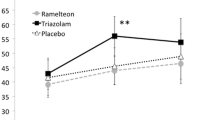Summary
We have given 12 healthy subjects the H1-antihistamine ebastine (20 mg) or placebo in a double-blind, crossover study for one week each. The subjects were tested for drug effects on Day 6 of each period, and for interactions of ebastine with ethanol (0.8 g·kg−1) on Day 7. On both days, the testing runs were done at baseline and at 2, 4, and 6 h after the drug. Performance was evaluated both objectively (digit symbol substitution, flicker fusion, Maddox wing, nystagmus, simulated driving, body balance) and subjectively (visual analogue scales) and with questionnaires. Venous blood samples were taken daily during maintenance and during each test run for assay of plasma carebastine. Blood ethanol concentrations were assayed with an Alcolmeter in the breath and directly in the blood. Plasma carebastine concentration reached a steady-state from Day 3 on; the mean concentrations in the morning were 92 µg·l−1 on Day 6 and 104 µg·l−1 on Day 7. The rise in plasma carebastine after an extra 20 mg of ebastine was accelerated but not increased by ethanol. Ebastine did not impair performance objectively or subjectively. It slightly improved body balance and reduced errors during simple tracking at 4 h. Blood ethanol concentrations peaked (mean 0.76 g·l−1) at 1.5 h after ethanol intake. Ethanol impaired performance in most objective tests and produced clumsiness, muzziness, and mental slowness, but little drowsiness. Ebastine neither modified the blood ethanol concentrations nor increased the effects of ethanol. We conclude that treatment with 20 mg ebastine once daily for one week provides steady concentrations of carebastine in plasma without impairment of skilled performance or important interactions with alcohol.
Similar content being viewed by others
References
Reference deleted
Vincent J, Liminana R, Meredith PA, Reid JL (1988) The pharmacokinetics, antihistamine and concentration-effect relationship of ebastine in healthy subjects. Br J Clin Pharmacol 26: 497–501
Vincent J, Sumner DJ, Reid JL (1988) Ebastine: the effect of a new antihistamine on psychomotor performance and autonomic responses in healthy subjects. Br J Clin Pharmacol 26: 503–508
Wood-Baker R, Holgate ST (1990) Dose-response relationship of the H1-histamine antagonist, ebastine, against histamine and methacholine-induced bronchoconstriction in patients with asthma. Agents Actions 30: 284–286
Mattila MJ, Kuitunen T (1990) Ebastine, a non-sadative H1-antihistamine without alcohol interaction. Eur J Pharmacol 183: 1653–1654
Wechsler D (1955) A manual for the Wechsler adult intelligence scale. Psychological Corporation, New York
Hindmarch I (1982) Critical flicker fusion frequency (CFF): the effects of psychotropic compounds. Pharmacopsychiatry 15 [Suppl 1]: 44–48
Hannington-Kiff JG (1970) Measurements of recovery from outpatient general anaesthesia with a simple ocular test. Br Med J III: 132–135
Savolainen K, Linnavuo M (1979) Effects of m-xylene on human equilibrium measured with a quantitative method. Acta Pharmacol Toxicol 44: 315–318
Palva E, Linnoila M (1978) Effect of active metabolites of chlordiaz-epoxide and diazepam, alone and in combination with alcohol, on psychomotor skills related to driving. Eur J Clin Pharmacol 13: 345–350
Linnavuo M, Ylilääkkölä P, Mattila MJ, Mäki M, Seppälä T (1987) A new device to measure drug-induced changes of reactive and coordinative skills related to driving. Pharmacol Toxicol 61: 142–147
Bond A, Lader M (1974) The use of analogue scales in rating subjective feelings. Br J Med Psychol 47: 211–218
Boxenbaum G, Riegelman S, Elashoff R (1974) Statistical estimations in pharmacokinetics. J Pharmacokinet Biopharm 2: 123–145
Jones AW (1978) A rapid method for blood alcohol determination by headspace analysis using an electrochemical detector. J Forensic Sci 23: 283–291
Nicholson AN (1976) Performance and impaired performance. Br J Clin Pharmacol 3: 521–522
Mattila MJ, Mattila M, Konno K (1986) Acute and subacute actions and interactions with diazepam of temelastine (SK & F 93944) and diphenhydramine on human performance. Eur J Clin Pharmacol 31: 291–298
Uzan A, LeFur G, Malgouris C (1979) Are antihistamines sedative via blockade of brain H1-receptors? J Pharm Pharmacol 31: 701–702
Paton DM, Webster DR (1985) Clinical pharmacokinetics of H1-receptor antagonists (the antihistamines). Clin Pharmacokinet 10: 477–497
Levander S, Hägemark Ö, Ståhle M (1985) Peripheral antihistamine and central sedative effects of three H1-receptor antagonists. Eur J Clin Pharmacol 28: 523–529
Moser L, Hüther KJ, Koch-Weser J, Lundt PV (1978) Effects of terfenadine and diphenhydramine, alone and in combination with diazepam or alcohol, on psychomotor performance and subjective feelings. Eur J Clin Pharmacol 14: 417–423
Hindmarch I, Bhatti JZ (1987) Psychomotor effects of astemizole and chlorpheniramine, in combination with alcohol. Int Clin Psychopharmacol 2: 117–119
Author information
Authors and Affiliations
Rights and permissions
About this article
Cite this article
Mattila, M.J., Kuitunen, T. & Plétan, Y. Lack of pharmacodynamic and pharmacokinetic interactions of the antihistamine ebastine with ethanol in healthy subjects. Eur J Clin Pharmacol 43, 179–184 (1992). https://doi.org/10.1007/BF01740667
Received:
Accepted:
Issue Date:
DOI: https://doi.org/10.1007/BF01740667




